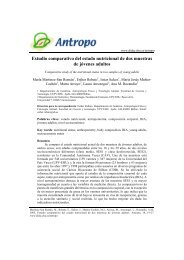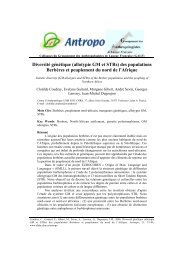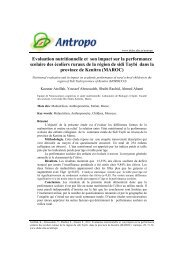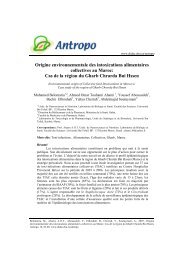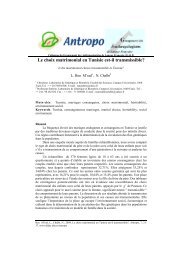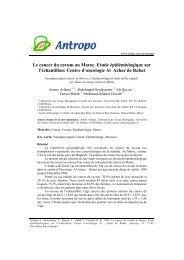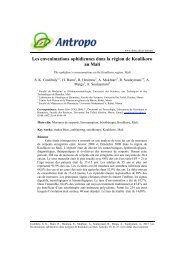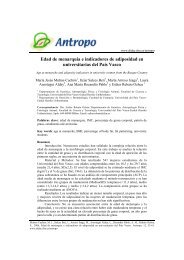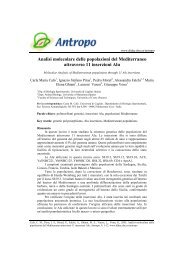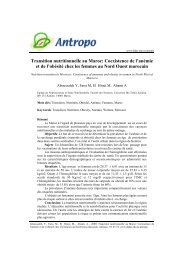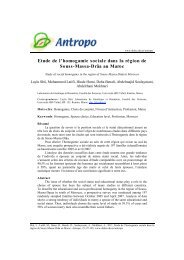Caractérisation anthropogénétique de la population de Msirda ...
Caractérisation anthropogénétique de la population de Msirda ...
Caractérisation anthropogénétique de la population de Msirda ...
- No tags were found...
You also want an ePaper? Increase the reach of your titles
YUMPU automatically turns print PDFs into web optimized ePapers that Google loves.
Mortad et al., 2012. Antropo, 28, 41-48. www.didac.ehu.es/antropoFigure 4. P<strong>la</strong>n factoriel engendré par les <strong>de</strong>ux premiers axes <strong>de</strong> l'Analyse en Composantes Principales calculées àpartir <strong>de</strong>s fréquences <strong>de</strong>s figures digitales à l'échelle <strong>de</strong> <strong>la</strong> Méditerranée chez le sexe féminin.Figure 4. Factorial <strong>de</strong>sign generated by the first two axes of Principal Components Analysis calcu<strong>la</strong>ted fromfrequencies of digital figures across the Mediterranean (the female sex).Figure 5. Dendrogramme (distances Euclidiennes) obtenues à partir <strong>de</strong> <strong>la</strong> matrice <strong>de</strong>s fréquences <strong>de</strong>s<strong>de</strong>rmatoglyphes <strong>de</strong> quelques popu<strong>la</strong>tions d'Afrique du Nord, Moyen Orient et du Nord <strong>de</strong> <strong>la</strong> Méditerranée.Figure 5. Dendrogram (Eucli<strong>de</strong>an distances) obtained from the matrix of frequencies of the <strong>de</strong>rmatoglyphics ofsome popu<strong>la</strong>tions of North Africa, Middle East and North of the Mediterranean.Discussion et conclusionLa caractérisation anthropogénétique <strong>de</strong> <strong>la</strong> popu<strong>la</strong>tion <strong>de</strong> <strong>Msirda</strong> par les <strong>de</strong>rmatoglyphesdigitaux a permis <strong>de</strong> relever <strong>de</strong>s caractéristiques majeures pouvant positionner cette popu<strong>la</strong>tiondans le contexte Nord Africain et Méditerranéen.Les résultats révèlent <strong>la</strong> dominance <strong>de</strong>s boucles ulnaires, suivies <strong>de</strong>s tourbillons, <strong>de</strong>s arcs etenfin <strong>de</strong>s boucles radiales.Les résultats concor<strong>de</strong>nt avec ceux <strong>de</strong> <strong>la</strong> plupart <strong>de</strong>s popu<strong>la</strong>tions humaines (Pons, 1952).47



